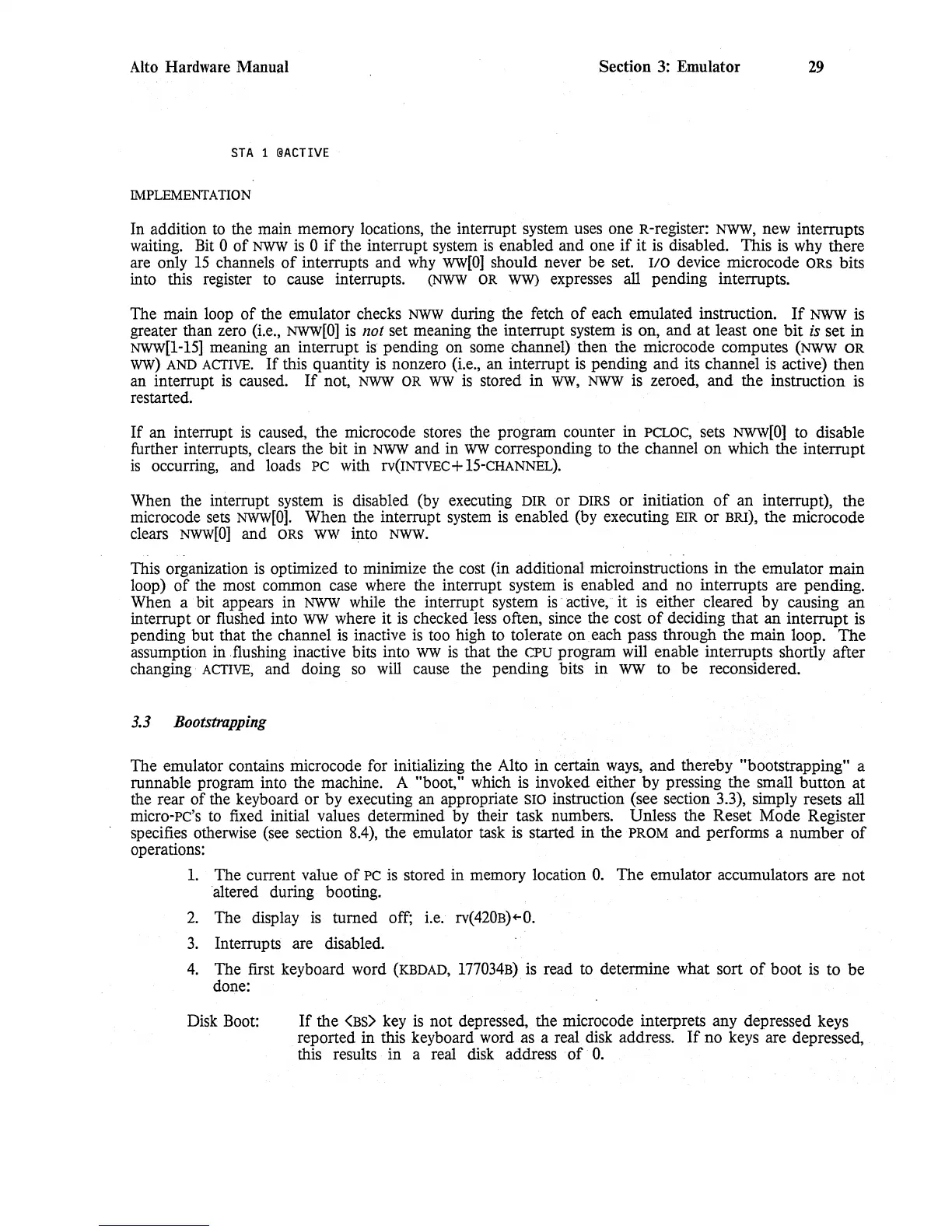Alto Hardware Manual
Section 3: Emulator
29
STA
1
@ACTIVE
IMPLEMENTATION
In addition
to
the main memory locations, the interrupt system uses one R-register:
NWW,
new interrupts
waiting.
Bit
0
of
NWW
is
0
if
the interrupt system
is
enabled and one
if
it
is
disabled. This is
why
there
are only
15
channels
of
interrupts and
why
ww[O]
should never be set.
lIO
device microcode
ORS
bits
into this register to cause interrupts.
(NWW
OR
WW)
expresses all pending interrupts.
The main loop
of
the emulator checks
NWW
during the fetch
of
each emulated instruction.
If
hTWW
is
greater than zero (i.e.,
NWW[O]
is not set meaning the interrupt system
is
on, and
at
least one bit
is
set in
NWW[I-IS]
meaning an interrupt
is
pending on some channel) then the microcode computes
(NWW
OR
ww)
AND
ACTIVE.
If
this quantity
is
nonzero
(Le.,
an interrupt
is
pending and its channel
is
active) then
an interrupt
is
caused.
If
not,
NWW
OR
WW
is
stored in
WW,
NWW
is
zeroed, and the instruction is
restarted.
If
an interrupt
is
caused, the microcode stores the program counter in
PCLOC,
sets
NWW[O]
to disable
further interrupts, clears the bit in
NWW
and in
WW
corresponding to the channel on which the interrupt
is
occurring, and loads
PC
with
rv(INTVEC+
IS-CHANNEL).
When the interrupt system
is
disabled (by executing
DIR
or
DIRS
or initiation
of
an interrupt), the
microcode
sets
NWW[O].
When the interrupt
system
is
enabled (by executing
EIR
or
BRI),
the microcode
clears
NWW[O]
and
ORS
WW
into NWW.
This organization
is
optimized to minimize the cost (in additional microinstructions in the emulator main
loop)
of
the most common case where the interrupt system
is
enabled and
no
interrupts are pending.
When a
. bit appears in
hTWW
while the interrupt system is· active, it is either cleared by causing an
interrupt or flushed into
WW
where it
is
checked
less
often, since the cost
of
deciding that an interrupt
is
pending but that the channel
is
inactive
is
too high to tolerate on each pass through the main loop. The
assumption in flushing inactive bits into
WW
is
that the
CPU
program will enable interrupts shortly after
changing·
ACTIVE,
and doing
so
will
cause the pending bits in
WW
to be reconsidered.
3.3
Bootstrapping
The emulator contains microcode for initializing the Alto in certain
ways,
and thereby "bootstrapping" a
runnable program into the machine. A
"boot," which is invoked either by pressing the small button
at
the rear of the keyboard or by executing an appropriate
8IO
instruction (see section 3.3), simply resets all
micro-PC's
to
fixed initial values determined by their task numbers. Unless the Reset Mode Register
specifies otherwise
(see
section
8.4),
the emulator task is started in the
PROM
and performs a number
of
operations:
1.
The current value
of
PC
is
stored in memory location
O.
The emulator accumulators are not
·altered during booting.
2.
The display
is
turned off;
Le.
rv(420B)
+-0.
3.
Interrupts are disabled.
4.
The first keyboard word
(KBDAD,
177034B)
is read
to
determine what sort
of
boot
is
to be
done:
.
Disk Boot:
If
the (BS)
key
is
not depressed, the microcode interprets any depressed keys
reported in this keyboard word as a real disk address.
If
no keys are depressed,
this results in a real disk address
.
of
O.
